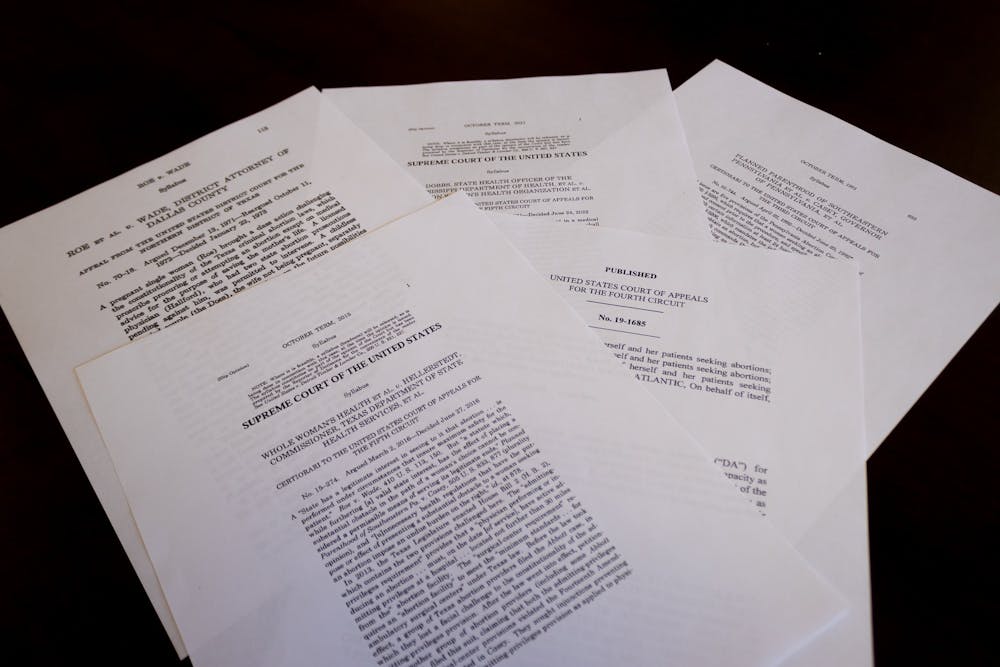“The crucial judicial pronouncement in Roe v. Wade is that the federal Constitution speaks to the issue of abortion,” Maxine Eichner, a professor in the UNC School of Law, said. “And what it says is that the right to choose an abortion is a fundamental right protected by the U.S. Constitution.”
Planned Parenthood of Southeastern Pennsylvania v. Casey
This 1992 case affirmed that the Constitution protects the right to an abortion, but the U.S. Supreme Court essentially abandoned the trimester framework established by Roe v. Wade, Krause said.
The court confirmed that Roe v. Wade did not establish an “unqualified” right to an abortion. Instead, it protects the pregnant person from “unduly burdensome interference" while seeking an abortion.
Krause said that an “undue burden” is placing a substantial obstacle in the way of someone seeking abortion care.
“In our view, the undue burden standard is the appropriate means of reconciling the state’s interest with the woman’s constitutionally protected liberty,” the court wrote in the decision.
But what this means is not specifically laid out.
“The key then becomes ‘What’s an undue burden?’” Eichner said. “And the court didn’t really explain that.”
Whole Woman’s Health v. Hellerstedt
Eichner said the 2016 case Whole Woman’s Health v. Hellerstedt — which voided a Texas law that would have shut down many abortion clinics in the state — established an example of what was considered an “undue burden.”
The law required physicians who performed abortions to have admitting privileges at a hospital no more than 30 miles away from the clinic.
When the law took effect, it cut the number of Texas abortion clinics in half and doubled the number of "women of reproductive age" living more than 50 miles from a clinic, according the the Supreme Court decision.
To get the day's news and headlines in your inbox each morning, sign up for our email newsletters.
“The majority held that the undue burden standard requires that you basically balance burdens and benefits,” Krause said.
Dobbs v. Jackson Women’s Health Organization
In June 2022, the Supreme Court ruled in Dobbs v. Jackson that the Constitution does not protect the right to an abortion.
The case was in reference to a Mississippi abortion ban after 15 weeks of pregnancy.
Dobbs v. Jackson did not ban all abortions nationwide. But Krause said under the new ruling, federal courts have no ability to regulate abortion access because it is no longer under the jurisdiction of the Constitution. Instead, it is left to state legislative bodies.
“Roe and Casey are overruled,” the decision stated. “And the authority to regulate abortion is returned to the people and their elected representatives.”
But individual states can choose to establish almost any laws related to abortion and abortion access, as long as they are not completely irrational, Eichner said.
“What it does has to make sense,” she said. “But completely banning abortion under (Dobbs’) framework would make sense.”
Bryant v. Woodall
In 2019, the U.S. District Court for the Middle District of North Carolina ruled in Bryant v. Woodall to place an injunction on a 1973 law banning abortions after 20 weeks of pregnancy.
But, after the Dobbs decision was announced, a North Carolina judge ruled in August that this injunction no longer had a foundation — as it was based on the implications of Roe and Casey — and the ban was reinstated.
“The earlier decision in Bryant had relied on a constitutional right — a pregnant person’s fundamental right to choose abortion,” Eichner said. “Given the rationale of that earlier decision, the court said there's no longer any reason for that injunction against the abortion law between 20 weeks and viability to stand any longer.”
Abortions after 20 weeks are no longer legal in North Carolina, except in medical emergencies where necessary to prevent the death of or irreversible harm to the mother.
Wider implications and privacy law
Under Roe v. Wade and Planned Parenthood v. Casey, the right to an abortion was protected under the “right to privacy.” Many cases decided around the same time as Roe also upheld rights under this idea, Eichner said — for example, cases related to contraception and interracial marriage.
“All of those cases hinged on this idea that there's kind of this zone of privacy that is yours to decide,” Krause said. “And no government can really touch it.”
The language “right to privacy” is not specifically used in the Constitution — though it is implied in several amendments. But, Casey refers to it as a form of personal “liberty,” which is guaranteed in the Constitution.
In the Casey decision, the majority established that court precedent does not support limiting citizen’s protected rights to only those explicitly laid out in the Constitution.
“It is tempting, as a means of curbing the discretion of federal judges, to suppose that liberty encompasses no more than those rights already guaranteed to the individual against federal interference by the express provisions of the first eight Amendments to the Constitution,” the decision stated. “But of course this Court has never accepted that view.”
Eichner said that the Supreme Court now looks to historical perspectives from the time when the Constitution or an amendment was passed. The Court asks did they think the right was protected by the Constitution — or even a right at all?
“The Court finds that the right to an abortion is not rooted in our nation’s history and tradition,” the Dobbs decision stated.
But Eichner said that “history and tradition” that the Court references and summarizes in the decision is “cherry-picked.”
Regardless, questions remain about whether the other rights previously thought to be settled under a “right to privacy” will still be protected.
“How many of those older cases that form the basis for everything are now threatened by Dobbs?” Krause said. “Or, as the majority said, is Dobbs only about abortion?"
@hannahgracerose
university@dailytarheel.com




